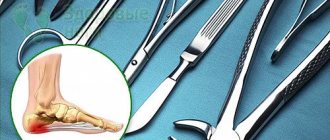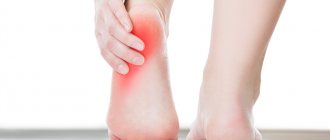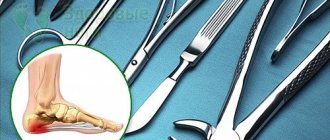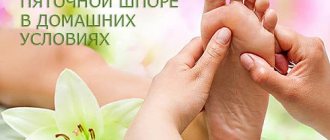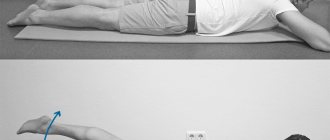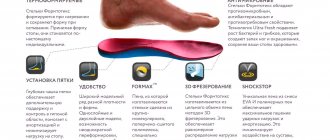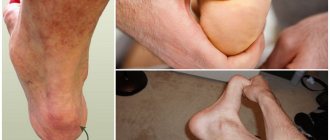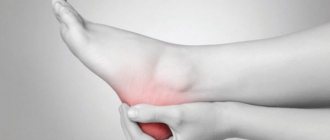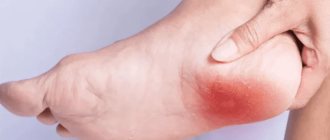September 9, 2016
Heel spur is one of the most common pathologies of the musculoskeletal system. It accounts for about 10% of all orthopedic diseases. Heel spur, or plantar fasciitis, is
inflammatory-dystrophic lesion of the plantar fascia, which occurs against the background of deposition of calcium salts in the area of the heel tubercle.
- Bile
- Dimexide
- Iodine
- Vinegar
- Salt
- Honey
- X-ray therapy
- Blockades
- Injections
- Medicines
Causes of heel spurs
The cause of heel spur formation is inflammation of the plantar fascia due to increased load on it or due to its insufficiency. The development of the inflammatory-degenerative process in the tissues of the aponeurosis is promoted by:
- flat feet with longitudinal deformation of the foot;
- sedentary lifestyle;
- excess body weight;
- long-term static loads on the feet (standing, walking in high heels, using uncomfortable shoes);
- sudden loads on the foot after a long period of rest;
- microtraumas during intense sports training.
Symptoms of heel spurs
The main manifestation of pathology is pain. In the first stages of the disease, it occurs while walking. As the severity of the pathology develops and worsens, the pain becomes stronger and more acute. Particularly characteristic of plantar fasciitis is the “starting” pain that occurs when movement begins after a long break or sleep.
During examination of the foot, no obvious clinical signs are usually observed; in some cases, slight swelling in the heel area is noted. Palpation reveals pain in the lateral areas of the heel bone and in the middle of the heel from the side of the sole.
The intensity of pain and the severity of symptoms of pathology may vary and do not depend on the size of the bone formation. Thus, even a small growth in the area of the heel tubercle can cause acute burning pain and cause complete disability for the patient, while the formation of a large osteophyte in another patient may manifest only minor discomfort while walking.
Today, there are many known ways to treat heel spurs - both clinical and folk. In this article we will look at both in detail. The first part of the article is devoted to home treatment methods for heel spurs - we will not judge their effectiveness, but will only give a brief overview of the methods of their use.
However, let us remind you that any attempts at self-treatment without consulting a competent doctor are fraught with the development of even more serious complications and can only lead to a deterioration in the patient’s well-being. It is necessary to understand that the use of home treatment methods instead of full-fledged medical therapy will only slow down the patient’s recovery and lead to the progression of the disease.
Rules for self-massage
Before starting massage treatment, read the rules and recommendations of specialists, the implementation of which will help you avoid mistakes and side effects:
- For improvements to occur, self-massage must be done regularly. The optimal mode is daily in the evening.
- Increase the force of impact gradually.
- Massage the hard areas around the spur with maximum pressure, which causes tolerable pain.
- After the session, it is mandatory to use a Strasbourg sock. At this time, the fascia is relaxed and stretched; it is important to fix it in this position throughout the night.
- If the pain intensifies after the procedure, then next time reduce the intensity and pace.
Attention! You cannot use such barbaric methods of “massage” as hitting with a rolling pin and other objects. Such techniques can be found in magazines and on the Internet; their use often leads to foot injuries.
Orthopedic insoles for heel spurs
One of the most effective means used to treat and prevent the formation of heel spurs are orthopedic insoles. Their use is necessary to unload the foot and improve shock absorption of the musculoskeletal system when walking. Individual orthopedic insoles, made to order by an orthopedic specialist, most effectively eliminate pain and relieve stress on the feet during movement. In this case, the anatomical shape of the patient’s foot is taken into account, which allows you to accurately select and adjust the shape of the insoles. Wearing orthopedic insoles provides maximum comfort for the patient, both while walking and in a static position.
The medical department manufactures and selects individual Formthotics orthopedic insoles. To do this, an orthopedic doctor using a special device - a plantoscope - examines the condition of the tissues of the feet, identifying possible deformations of their longitudinal and transverse arches.
After a thorough plantoscopic diagnosis, the doctor makes individual insoles that most accurately follow the anatomical lines of the patient’s feet and create ideal conditions for the functioning of their musculoskeletal system. The insoles are heated with a hairdryer to make the material plastic, the patient stands on them and the doctor records the exact imprint of the feet in a static position and while walking.
Continuous wearing of Formthotics custom insoles stops the progression of plantar fasciitis, stimulates the restoration of foot tissues and promotes their healing, accelerating the patient's recovery.
Heel pads
One of the types of orthopedic insoles are heel pads. These are orthopedic products, which are shock-absorbing inserts under the heel. They are made from various natural or synthetic materials (leather, balsa, gel, silicone) to reduce the impact load on the foot and reduce pain in the heel during movement.
Patch for the treatment of heel spurs
Among the home remedies for heel spurs, special pharmaceutical plasters are quite common. In particular, pepper patch is used for severe pain for applications on the heel area for several days.
What effect does the adhesive plaster have in this case?
The active components with which it is impregnated (pepper, belladonna extract) have a local irritating effect, increasing blood circulation and lymph flow in the tissues of the heel area. This reduces local swelling and inflammation, and also reduces the intensity of pain.
No less popular is the Chinese patch for the treatment of heel spurs. Its therapeutic effect is to stimulate the reflexogenic zones of the heel area along with an anti-inflammatory effect on the tissue.
Ointment for the treatment of heel spurs
To treat heel spurs at home, various anti-inflammatory ointments and creams are often used. Among them, indomethacin and hydrocortisone ointments are most often used.
When treating the heel area, indomethacin ointment has an analgesic effect on the tissue and eliminates local inflammation. Hydrocortisone ointment, which has a hormonal effect, reduces local swelling and the intensity of the inflammatory process. For home treatment of heel spurs, anti-inflammatory pain-relieving ointments ibuprofen, diclofenac and voltaren are also used.
However, it should be remembered that all of the listed medications do not eliminate the causes of heel spurs, but only smooth out the symptoms of the disease. In addition, their long-term and uncontrolled use in the absence of proper etiotropic treatment can lead to the development of side effects and aggravation of the severity of the disease.
Result
The blockade not only has an analgesic effect, corticosteroids weaken the inflammatory response.
The effectiveness of a one-time heel spur blockade is more than 90%.
In rare cases, a repeat procedure is performed.
It is worth understanding that the blockade, although it quickly brings relief, does not treat the cause of the pain.
Only complex therapy, and sometimes only surgical intervention. can permanently save the patient from an unpleasant disease and return him to the ability to move freely.
Exercises for heel spurs
One widely used home treatment for heel spurs is foot exercises. The main goal of the exercises is to stretch the plantar fascia and strengthen the muscles of the longitudinal arch of the foot, which helps to increase the elasticity of the tissues and strengthen them.
The most effective exercises are rolling with the foot of a tennis ball, picking up small objects from the floor with the toes, etc. Exercises should be done after mandatory preliminary warm-up and warming up of the muscles.
Rotation of the feet has a beneficial effect on joint mobility, the condition of the muscles and ligaments of the legs. These exercises are performed while sitting on a chair: with your legs stretched forward, you rotate your feet in and out for 15 seconds, making sure that your thumbs are pointing upward.
Thanks to therapeutic exercises, blood supply to the plantar aponeurosis and foot muscles is improved, local metabolic processes are activated, tissue nutrition is improved, which helps accelerate their healing and reduces the risk of microtrauma.
Massage for heel spurs
Massage is widely used to treat heel spurs at home. The purpose of massage for plantar fasciitis is to relieve muscle spasm, increase microcirculation in the affected area, activate local metabolism, reduce pain and improve tissue trophism. The massage technique combines stroking, rubbing, kneading tissue in the heel area and the entire sole, pinching and pressing.
The therapeutic effect of massage in this case can only be obtained when it is combined with other therapeutic methods (physiotherapy, drug treatment, etc.).
Treatment of heel spurs with folk remedies
There are many ways to treat heel spurs using traditional medicine.
Bile
Medical bile, which can be purchased at a pharmacy, has long been used for therapeutic compresses for heel spurs. When applied to tissue in the area of the pathological focus, the drug has a warming, analgesic effect and accelerates the resolution of the inflammatory process.
Dimexide
Dimexide is a fairly popular remedy for home treatment of heel spurs. A bandage is moistened with the drug solution and applied as compresses to the affected area. By acting locally on tissue, dimexide reduces pain and the intensity of inflammation, stimulates tissue metabolism, accelerates the resorption of infiltrates and tissue regeneration.
Iodine
Iodine solution is also used for topical treatment of plantar fasciitis. Applications of iodine solution have a local warming and antiseptic effect on tissue, accelerate local blood flow, improve tissue nutrition, gradually eliminating inflammation.
Vinegar
To get rid of heel spurs in folk medicine, a mixture of vinegar, butter and a chicken egg is used. The thoroughly mixed mixture is applied in the form of compresses to the heel area in order to activate local blood circulation and metabolism, reduce pain and accelerate the resorption of bone growth.
Salt
Salt compresses and baths are also considered one of the most effective home remedies for heel spurs. Salt applications have an analgesic, anti-inflammatory and absorbable effect on tissue.
Honey
Compresses of honey and salt applied at night gradually relieve heel pain, improve metabolism and tissue nutrition, accelerate the resorption of painful infiltrates and relieve acute inflammation.
Blockade in the spine: consequences and their prevention
Complications occur only in 0.5% of cases. These may include unexpected reactions to medications such as dizziness, vomiting, or increased heart rate. Damage to blood vessels at the injection point with the formation of a hematoma, infection and bleeding is also possible. Allergic reactions are possible. For preventive purposes, additional injections are given, and a test test is performed to prevent allergies. Our center has all the conditions for safely performing therapeutic blockades that will relieve you of debilitating pain for a long time. You don't have to worry about possible consequences or poor quality pain relief.
We employ high-level specialists with extensive experience, making patients feel comfortable and confident. If necessary, you will be prescribed one or more intra-articular injection procedures and a drug will be selected based on the indications.
Clinical treatments
No matter how effective traditional medicine may seem, limiting yourself to their use is absolutely unreasonable and unacceptable. A full medical examination and the prescription of adequate therapy are absolutely necessary, because plantar fasciitis is a serious disease.
Which doctor should you contact?
If you experience symptoms of a heel spur, you should consult an orthopedic doctor or surgeon. After examination and carrying out the necessary diagnostic tests, the doctor prescribes a treatment regimen, selects suitable orthoses, and, if necessary, gives a referral to see specialists of another profile (physiotherapist, massage therapist, exercise therapy instructor, etc.).
What are the most commonly used clinical treatments for heel spurs?
X-ray therapy
Radiation therapy is used when conservative treatment is ineffective and pain is persistent. Local exposure to x-rays on tissue in the area of bone growth produces a prolonged analgesic effect. Treatment is carried out in several sessions, the duration of one procedure is about 10 minutes. Contraindications to X-ray therapy are pregnancy and breastfeeding.
Blockades
Drug blockades are carried out in cases where conservative therapy for plantar fasciitis does not bring the desired result. Injections of drugs into the area of the pathological focus have an analgesic effect and eliminate inflammation in the tissues.
Injections
For intense pain in the heel area, injections with hormonal drugs of steroid origin (hydrocortisone, diprospan, kenalog) have a good effect. Injections of these drugs into the osteophyte area quickly relieve pain and relieve inflammation.
Medicines
Conservative treatment of heel spurs is carried out in combination with drug therapy. The group of medications used in this case includes:
- analgesic drugs;
- non-steroidal anti-inflammatory drugs (ibuprofen, diclofenac);
- hormonal drugs of steroid origin (hydrocortisone);
- local anti-inflammatory drugs (dimexide, etc.).
Advantages
- fast, complete and long-lasting pain relief;
- additional therapeutic effect due to the acceleration of recovery processes;
- possibility of repeated use;
- minimum of adverse reactions.
For tonic syndromes caused by muscle tension, blockades can relieve discomfort for several months or even years. For more serious diseases, anti-inflammatory and hormonal agents are added to the anesthetics, as well as chondroprotectors for cartilage regeneration. When introduced into a sore spot, they are much more active than droppers, tablets or ointments. Therefore, therapeutic blockades in neurology are much more effective than pharmaceutical drugs and physiotherapy.
Treatment of heel spurs at the ALFA TECHNOLOGIES clinic
Medical treatment of heel spurs is performed using conservative methods, including physiotherapy, pharmacotherapy, massage and drug blockades. The most pronounced therapeutic effect in this disease is provided by shock wave therapy - a unique treatment technique based on the effect of low-frequency acoustic shock waves on tissue.
Penetrating into the affected area to a clearly defined depth, wave vibrations cause a whole range of positive changes in the tissues:
- Blood circulation and lymph circulation improves.
- Local metabolism becomes more intense.
- The structural elements of bone formation become loose and dissolve.
- Spasmed muscles relax.
- The local inflammatory reaction is eliminated.
- The pain gradually decreases, and by the end of the therapeutic course it disappears completely.
- The processes of tissue repair and restoration are activated.
Complete treatment of heel spurs using the shock wave method involves completing a course of 5-8 procedures. The effectiveness of this treatment is very high: at the end of the course, complete disappearance of painful symptoms and recovery occurs in 97% of patients.
Treatment of plantar fasciitis with the shock wave method has a number of advantages over other methods:
- Absolute safety and harmlessness (virtually no contraindications);
- Pain and signs of local inflammation disappear after the first procedure;
- Treatment does not require the use of medications or pain relief;
- Exposure to acoustic waves improves the absorption of drugs into affected tissues and increases the effectiveness of pharmacotherapy.
Shock wave therapy is an advanced technique that guarantees rapid healing for heel spurs. Come to us - we will help you restore the health of your feet. Discover a world of ease of movement - it will take care of you!
What types of blockades are there?
Local
The doctor gives an injection exactly in the area where there is damage. The drug can be administered near or under it, hoping to get into the area of the inflammatory focus. When an injection is administered into the periarticular tissues, the blockade is called periarticular, and into the nerve trunks - perineural.
Segmental
The segmental method involves injecting an anesthetic into a specific spinal segment. This means that the medicine must enter the projection zone of this segment, corresponding to a specific nerve, vertebra or muscle.
Vertebral
The term "vertebral" means "vertebral, which refers to a vertebra" and is derived from the Latin vertebra - vertebra. The specialist inserts the needle subcutaneously into the space between the spinous processes of the vertebra (insertion depth - 2-4 cm) or into the vertebral body (depth - 8-10 cm).
Blockage in the spine for pain
A blockade in the spine for pain is carried out when nerve roots are pinched due to osteochondrosis, herniated intervertebral discs, neuralgia, spondyloarthrosis. Pain relief is achieved by temporarily “switching off” nerve conduction in a particular area. The introduction of anesthetics blocks the transmission of signals along the nerve fibers, and the pain recedes almost instantly. There is also a decrease in vascular spasm, swelling goes away, tissue self-healing processes are accelerated, and intracellular metabolism is normalized.
